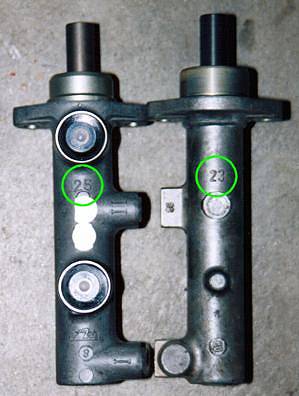| The one thing about brake pedals is that they can never really be too stiff. Anything that can be done to reduce brake pedal travel is going to improve sensitivity and confidence under heavy braking. Ideally pushing on the brake pedal should be like pushing your foot against a brick wall. The pedal would not move at all and you would modulate the brakes strictly by changing the force with which you pushed against the pedal. This is pretty much what a top level racecar brake pedal feels like (F1, CART ,WRC etc). Brake pedal travel and effort are adjusted by changing the amount of fluid moved by the brake pedal. This can be accomplished by changing the leverage ratio that the brake pedal has on the master cylinder or it can be achieved by changing the diameter of the brake master cylinder. The latter method is most common. | ||
 The E30 M3 comes from the factory with a 23 mm brake master cylinder. But BMW makes
a 25 mm brake master cylinder which was used in some of its bigger cars (including
the E32 750i produced from 87-94). A comparison of the two brake master cylinders
is shown at left. The green circles show where the sizes of the master cylinders
are cast into their housings.
The E30 M3 comes from the factory with a 23 mm brake master cylinder. But BMW makes
a 25 mm brake master cylinder which was used in some of its bigger cars (including
the E32 750i produced from 87-94). A comparison of the two brake master cylinders
is shown at left. The green circles show where the sizes of the master cylinders
are cast into their housings.
Increasing the master cylinder diameter from 23 mm to 25 mm leads to an 18% increase in cross sectional area. This means that for every centimeter that you depress your brake pedal you are moving 18% more brake fluid. The result is an 18% increase in brake pedal stiffness (i.e. an 18% reduction in brake pedal travel) - a noticeable improvement. Of course this comes at the expense of an 18% increase in brake pedal effort. But high brake effort is generally considered to increase driver sensitivity, along with a firmer pedal, so this is really a win-win situation (and those are rare!). Carol Smith's recommendation on brake master cylinder sizing is to make the MC diameter "as big as the driver can handle". | ||
|
| ||
|
Ed. Note:
Swedish E30 M3 owner Gunnar Ístlund has pointed me to the ATE online catalogue
( www.ate-brakes.com ). Gunnar explains that both this catalog, and the BMW Parts Catalog can be used to show that the actual (instead of rounded off) diameters for the E32 750i and E30 M3 brake master cylinders are 25.40mm and 23.81mm respectively. This means the the increase in bore diameter is not as great on a relative basis. The increase in fluid moved (i.e. the increase in stiffness) will be 13.8% which is a somewhat lower value than the 18% mentioned above. Thanks for the tip Gunnar. | ||
|
| ||
| The 25 mm brake master cylinder bolts directly onto the E30 M3 brake booster. You can also re-use your existing brake fluid reservoir. The part number for the 25 mm brake master cylinder is as follows: | ||
| ||
| Note: In order to implement the 25 mm brake master cylinder you will need to replace one of the brake hard lines. This is explained on page 2 » | ||
|
|